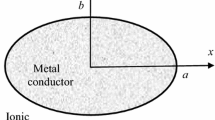Abstract
The method of electrical inversion in classical electrostatics is employed to obtain exact solutions for basic electrostatic problems pertaining to overlapping spheres/cylinders. The problems considered here include (1) a pair of overlapping conducting spheres, intersecting at a vertex angle π/n, n an integer, placed in a constant potential field; (2) a pair of infinitely long conducting circular cylinders, intersecting at a vertex angle π/n, n an integer, placed in a uniform field; and (3) a composite hybrid geometry consisting of two orthogonally intersecting infinitely long circular cylinders whose boundary is a combination of conducting and dielectric surfaces (with mixed boundary conditions) submerged in a uniform field. Applying the basic idea of Kelvin’s inversion repeatedly, solutions for the electric potentials are derived in each case. An exact expression for the capacitance in terms of the two radii, center-to-center distance, and the vertex angle is found for the twin sphere geometry. The capacity is then used to find the steady-state rate coefficient of a perfectly absorbing body placed in a thermally conducting environment of lower temperature. The equipotentials are plotted using the exact solutions of the two-dimensional problems and their features are discussed as well. The simple method illustrated here can be useful both as a teaching tool and as a building block for further computations.
Similar content being viewed by others
References
Thomson (Lord Kelvin) W (1845) Extrait D’une lettre de M. William Thomson a M. Liouville, Originally in. Journal de Mathematiques Pures eet Appliques 10: 364
Thomson (Lord Kelvin) W (1847) Extrait D’une lettre de M.William Thomson a M Liouville, Originally in. Journal de Mathematiques Pures eet Appliques 12: 256–264
Thomson (Lord Kelvin) W (1872) Reprint of papers on electricity and magnetism. Macmillan, London, pp, pp 144–146
Maxwell JC (1954) A treatise on electricity and magnetism, chap XI. Dover Publications, New York
Binns KJ, Lawrenson PJ (1973) Analysis and computation of electric and magnetic field problems. Pergamon Press, Oxford
Basset AB (1961) A treatise on hydrodynamics with numerous examples, vol 1 (1888). Dover Publications, New York
Milne-Thomson LM (1968) Theoretical hydrodynamics. Macmillan, London
Honein E, Honein T, Herrmann G (1992) On two circular inclusions in harmonic problems. Q Appl Math L(3): 479–499
Dassios G, Kleinmann RE (1989) On Kelvin inversion and Low-frequency scattering. SIAM Rev 31(4): 565–585
Palaniappan D, Felderhof BU (1999) Electrostatics of the conducting double sphere. J Appl Phys 86: 3418–3422
Lindell IV, Wallen KH, Shivola AH (2003) Electrostatic image theory for two intersecting conducting spheres. J Electromagn Waves Appl 17(11): 1643–1660
Felderhof BU, Palaniappan D (1999) Electrostatic capacitance of two unequal overlapping spheres and the rate of diffusion-controlled absorption. J Appl Phys 86(11): 6501–6506
Tong GP (1996) Electrostatics of two conducting spheres intersecting at angles. Eur J Phys 17: 244–249
Smoluchowski Mv (1916) Vortrage uber Diffusion, Brownsche Bewegung und Koagulation von Kolloidteilchen. Phys Z 17: 557–585
Berg HC, Purcell EM (1977) Physics of chemoreception. Biophys J 20: 193–219
Cichocki B, Felderhof BU (1995) Transient effects in diffusion-controlled absorption by a nonuniform sink of arbitrary constitution. J Chem Phys 102: 1824–1836
Van Bladel J (1968) Low frequency scattering by hard and soft bodies. J Acoust Soc Am 44: 1069–1073
Smythe WR (1968) Static and dynamic electricity, chap. IV. McGraw-Hill, New york
McPhedran RC, Poladian L, Milton GW (1988) Asymptotic studies of closely spaced, highly conducting cylinders. Proc R Soc Lond A 415: 185–196
Radchik AV, Smith GB, Reuben AJ (1992) Quasistatic optical response of separate, touching, and intersecting cylinder pairs. Phys Rev B 46: 6115–6125
Radchik AV, Paley AV, Smith GB, Vagov AV (1994) Polarization and resonant absorption of intersecting cylinders and spheres. J Appl Phys 76: 4827–4835
Pitkonen M (2008) Polarizability of a pair of touching dielectric spheres. J Appl Phys 103, Art. No. 104910
Author information
Authors and Affiliations
Corresponding author
Rights and permissions
About this article
Cite this article
Palaniappan, D. Analytic solutions for some basic problems in electricity involving intersecting sphere and circular cylinder pairs. Electr Eng 94, 107–116 (2012). https://doi.org/10.1007/s00202-011-0221-7
Received:
Accepted:
Published:
Issue Date:
DOI: https://doi.org/10.1007/s00202-011-0221-7




